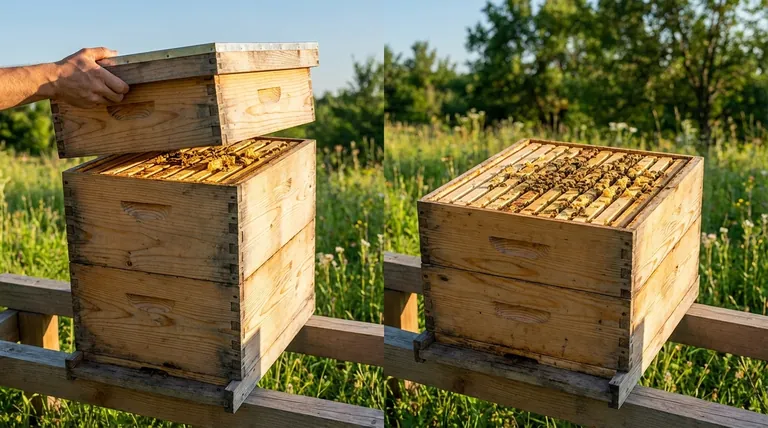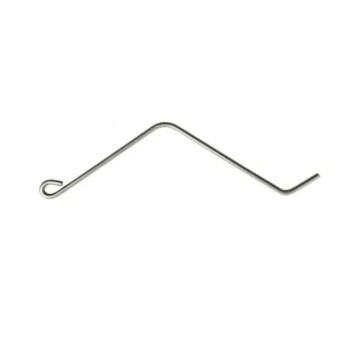At its core, the difference between an 8-frame and a 10-frame Langstroth box is its width and capacity. A 10-frame box is the traditional, wider standard, holding ten frames and thus more honey and brood. An 8-frame box is a more modern, narrower version that holds eight frames, making it significantly lighter and easier for the beekeeper to lift and handle.
The choice between an 8-frame and 10-frame hive is not about which is "better," but about a fundamental trade-off. You are choosing between the higher capacity and efficiency of the 10-frame system and the lighter, more manageable weight of the 8-frame system.

The Core Differences: A Head-to-Head Comparison
While the number of frames is the obvious distinction, the practical implications extend to nearly every aspect of beekeeping. Understanding these differences is critical to selecting the right equipment for your goals and physical abilities.
Width, Weight, and Handling
The most significant difference is physical size. An 8-frame box is narrower than a 10-frame box, and all its weight is contained within those eight frames.
This makes each individual box significantly lighter. A full, deep 10-frame box can weigh 80-90 pounds, while a comparable 8-frame box is closer to 60-70 pounds. This reduction in weight is the primary reason beekeepers choose the 8-frame system.
Capacity and Hive Configuration
A 10-frame box holds 25% more frames than an 8-frame box. This means it has a greater volume for the queen to lay eggs (the brood nest) and for bees to store honey and pollen.
Because of this smaller volume, an 8-frame hive will need to be expanded with new boxes more quickly as the colony grows. This often results in a taller hive that requires more individual boxes to equal the total volume of a shorter 10-frame hive.
Frame and Component Compatibility
This is a crucial point: frames are interchangeable between the two systems. A deep frame for a 10-frame hive will fit perfectly into an 8-frame deep box. The same is true for medium and shallow frames.
However, the hive bodies (the boxes themselves), bottom boards, and top covers are not interchangeable due to the difference in width. Once you commit to an 8-frame or 10-frame system, you must continue using components of that width.
How the Choice Impacts Your Beekeeping
The decision to use 8 or 10-frame equipment shapes your entire management routine, from routine inspections to honey harvesting.
Hive Inspections and Management
With a 10-frame hive, you have fewer boxes to work through during an inspection, but each lift is heavier.
With an 8-frame hive, you have more, but lighter, boxes to lift and inspect. The choice comes down to whether you prefer fewer heavy lifts or more frequent light lifts.
Honey Production Potential
The larger volume of a 10-frame hive generally supports a larger bee population, which is the engine for honey production. For beekeepers focused on maximizing yield, the 10-frame system has a higher potential.
While an 8-frame hive can be very productive, it may require more diligent management (like adding supers) to prevent the colony from running out of space, which can trigger a swarm.
Equipment Standardization
The 10-frame Langstroth hive is the original design and the long-standing industry standard in North America. This means equipment from different manufacturers is almost always compatible.
The 8-frame system is very popular but is a more recent modification. While generally consistent, you may encounter minor dimensional differences between suppliers, making it wise to buy your core components from a single source.
Understanding the Trade-offs
There is no perfect system. Each choice represents a compromise, and being aware of the downsides is as important as knowing the benefits.
The 8-Frame Compromise: Lighter Lifts, Taller Hives
The primary benefit of the 8-frame system is its lighter weight, which makes beekeeping more accessible to people with back problems or limited strength.
The main drawback is that you will own, manage, and inspect more individual pieces of equipment for a colony of the same size. Hives can become tall and potentially less stable.
The 10-Frame Compromise: Greater Volume, Heavier Lifts
The key advantage of the 10-frame system is its efficiency. It provides more space in a single, stable box, which can be better for large colonies and overwintering bees with ample food stores.
The undeniable drawback is the weight. Lifting a heavy 10-frame super full of honey is a significant physical challenge and a common reason experienced beekeepers switch to 8-frame equipment later in their careers.
Making the Right Choice for Your Goal
Your choice of equipment should directly support your personal beekeeping objectives.
- If your primary focus is minimizing physical strain: The 8-frame system is the definitive choice, as every lift will be lighter and more manageable.
- If your primary focus is maximizing honey production: The 10-frame system offers more volume for brood and honey, which generally supports a larger population and higher yields.
- If your primary focus is equipment availability and compatibility: The 10-frame system is the traditional standard with the widest selection of compatible parts from various suppliers.
- If you are undecided or want a hybrid approach: Consider a 10-frame system but commit to using only medium-depth boxes. This keeps the weight of any single box manageable while retaining the benefits of the wider hive body.
Ultimately, the best hive system is the one you are not afraid to inspect and can manage consistently and confidently.
Summary Table:
| Feature | 8-Frame Hive | 10-Frame Hive |
|---|---|---|
| Weight (Full Deep Box) | ~60-70 lbs | ~80-90 lbs |
| Frame Capacity | 8 Frames | 10 Frames |
| Hive Profile | Taller, more boxes | Shorter, fewer boxes |
| Best For | Reducing physical strain | Maximizing honey production potential |
| Equipment Compatibility | Components not interchangeable with 10-frame | Industry standard, wide compatibility |
Ready to Build Your Ideal Apiary?
Whether you're a commercial apiary scaling up operations or a distributor stocking for beekeepers, choosing the right equipment is crucial for success. HONESTBEE supplies durable, high-quality 8-frame and 10-frame Langstroth boxes and a full range of compatible beekeeping supplies through our wholesale-focused operations.
We help you make the right choice for your specific goals, ensuring your beekeeping operation is efficient, productive, and sustainable.
Let's discuss your needs and build a solution together. Contact our wholesale team today!
Visual Guide

Related Products
- Long Langstroth Style Horizontal Top Bar Hive for Wholesale
- Wholesales Dadant Size Wooden Bee Hives for Beekeeping
- Professional Engraved Round Hive Number Tags for Beekeeping
- Automatic Honey Flow Beehive 4 Frame Mini Hive for Beekeeping
- Professional Wooden Requeening Frame for Beekeeping
People Also Ask
- What are the benefits of a top bar hive? A Natural, Low-Impact Approach to Beekeeping
- How does the design of a top bar hive benefit beekeepers? Ergonomic & Natural Beekeeping for Hobbyists
- What are the main differences between Langstroth hives and top bar hives? Choose the Right Hive for Your Beekeeping Goals
- What are the benefits of the top bar hive? A Guide to Ergonomic, Natural Beekeeping
- What is a top bar bee hive? A Natural, Low-Stress Beekeeping Solution












